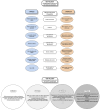Sex Differences in the Lacrimal Gland: Implications for Dry Eye Disease
- PMID: 40332492
- PMCID: PMC12028224
- DOI: 10.3390/ijms26083833
Sex Differences in the Lacrimal Gland: Implications for Dry Eye Disease
Abstract
Sexual dimorphism significantly impacts the lacrimal gland's structure, function, and ageing processes, playing an important role in dry eye disease (DED) pathophysiology. This multifactorial disorder, characterised by tear film instability, inflammation, and visual impairment, disproportionately affects women, especially after menopause. It highlights the interplay between sex steroid hormones, lacrimal gland function, and environmental factors. Systemic and local androgens are vital for maintaining lacrimal gland health and tear production, while the role of oestrogens remains less clear. Evidence suggests dose and context-dependent effects on inflammation and glandular function. Histopathological and molecular studies reveal significant sex differences in the lacrimal gland, with women exhibiting more pronounced age-related degenerative changes, including fibrosis and acinar atrophy, contributing to their increased susceptibility to DED. Despite these findings, the underlying mechanisms connecting sex steroid hormones, receptor expression, and local tissue regulation to these disparities remain poorly understood, highlighting the need for further research. This review synthesises the current knowledge of sex-specific differences in the lacrimal gland, emphasising the importance of integrating systemic and local biomarkers, histological data, and molecular insights into personalised therapeutic strategies. By tailoring treatments to patients' unique hormonal and molecular profiles, personalised medicine has the potential to transform DED management, addressing unmet clinical needs and improving outcomes.
Keywords: androgens; dry eye disease; lacrimal gland; oestrogens; personalised treatment; sex steroid hormones; sexual dimorphism; tear film.
Conflict of interest statement
The authors declare no conflicts of interest.
Figures




References
Publication types
MeSH terms
Substances
LinkOut - more resources
Full Text Sources

